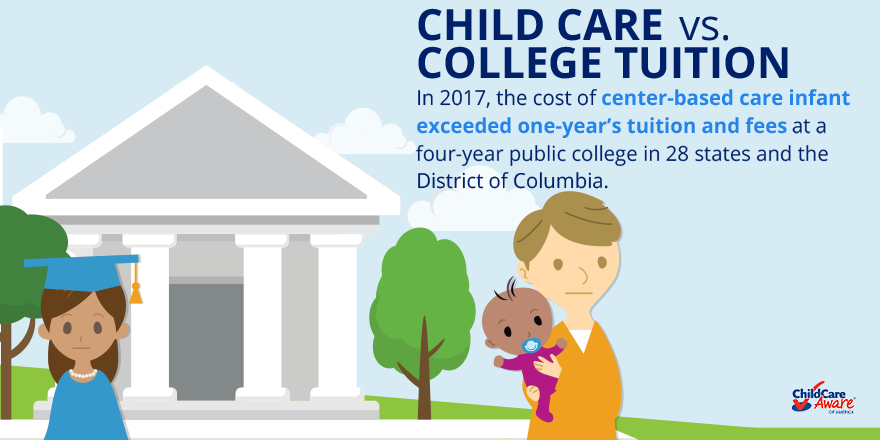WASHINGTON, DC — Child Care Aware® of America (CCAoA) today released its 12th annual The US and the High Cost of Child Care: A Review of Prices and Proposed Solutions for a Broken System which found that child care is unaffordable in all 50 states, plus the District of Columbia. For 30 years, CCAoA has been the leading voice for quality, affordable child care in the United States. Of note, our findings showed that across all states, the cost of center-based infant care exceeds 27 percent of median household income for single working parents—these impacts were exacerbated for parents and families of color in 2017.
We also found that child care fees for two children in 2017 exceeded mortgage payments in 35 states and the District of Columbia; while the average annual cost for an infant in center-based care was higher than one year at a four-year public college in 28 states and the District of Columbia.
Massachusetts was the least affordable state this year for center-based care for toddlers, California is the least affordable state for families with an infant in center-based care. Utah, Oregon, Minnesota, New York, Washington and Hawaii round out the nation’s most unaffordable states for infant and toddler child care.
New in this year’s report are county-level costs for ten states (Alaska, Arizona, Delaware, Hawaii, Indiana, Maryland, Massachusetts, Michigan, Minnesota, and Missouri) through our interactive map. We have also included expanded reporting on the average cost of summer child care for school-aged children. A more detailed supplement will be released in 2019.
Report highlights include:
- In every state, the average cost of center-based infant care is more than 27 percent of median income for single parents, an increase of three percentage points from 2016.
- Even for families of three earning double the federal poverty threshold (or $40,320), child care is a significant burden. Center-based infant care ranges from almost 13 percent of income for a low-income family in Mississippi to nearly 50 percent in Massachusetts.
- In our analysis of a national average cost of child care, we found that couples across the country pay more than 10 percent of their household income, for a year of child care for one child—that’s nearly $9,000 a year, no matter how you calculate it.
- Married couples pay 11 percent of their income toward child care. Single parents pay 37 percent of their income.
- The lifetime cost of diapers is around $2,000 about the same as a month of infant center-based child care costs in Massachusetts and D.C., the most expensive places in the U.S. to pay for infant center-based child care (Massachusetts: $1,677/month, D.C. $1,924/month).
- In 2017, the cost of center-based child care for an infant exceeded the costs of food and transportation combined in all regions of the country (Northeast, Midwest, South, and West).
- Child care workers in every state pay half their salary to cover the child care cost for two children.
Dr. Lynette M. Fraga, executive director of Child Care Aware® of America said, “Quality, affordable child care should be available and accessible to all children in the U.S.—regardless of age, race, ethnicity, socioeconomic status or geographic location. Since 60 percent of children under age six have both parents in the workforce and working mothers make up 40 percent of the workforce, the lack of access to quality, affordable care hurts most children and all communities—this is not an issue reserved only for parents and families. Congress has a real opportunity, as it weighs its priorities to provide relief to working families struggling to afford child care. With the 2018 midterm elections occurring in a few short days, it is our hope that parents, families, providers and communities will accelerate child care as a critical issue driving our nation’s economic successes and our obligation to help ease the burden on American families.”
CCAoA works with state Child Care Resource and Referral (CCR&R) agencies to track the cost of care for children by age and setting, then compares each state’s costs to its median income, ranking the states by affordability for each category of care. CCAoA’s interactive map shows the relationship between costs and median income by state. The organization has also partnered with the Economic Policy Institute (EPI) to add this year’s data to an online interactive calculator of child care expenses by area.
More than 11 million children under the age of five are in some form of child care in the United States; roughly 35 percent of children in care under age five are in child care centers. As the nation’s leading voice for child care, CCAoA is comprised of 125,000 online advocates from across the country and hundreds of members. More than 250 parents have shared their stories with lawmakers through their Family Advocacy Summit and Day on The Hill. For child care providers, they offer training on emergency preparedness as well as technical assistance that emphasize health, nutrition and obesity prevention and more.
To join the Capitol Hill briefing for more context to the data on October 24, 2018, from 10-11 AM EST, RSVP to raeann.pickett@usa.childcareaware.org.
To learn more about CCAoA’s advocacy efforts visit childcareworks.org. And you can follow the movement for child care on Twitter, Instagram and Facebook using @ChildCareWorks.
# # #
About Child Care Aware® of America
Child Care Aware® of America is our nation’s leading voice for child care. CCAoA works with state and local Child Care Resource and Referral agencies (CCR&Rs) and other community partners to ensure that all families have access to quality, affordable child care. CCAoA leads projects that increase the quality and availability of child care, offer comprehensive training to child care professionals, undertake research, and advocate for child care policies that improve the lives of children and families. To learn more, visit usa.childcareaware.org. Follow them on Twitter @USAChildCare and on Facebook at facebook.com/usachildcare.






